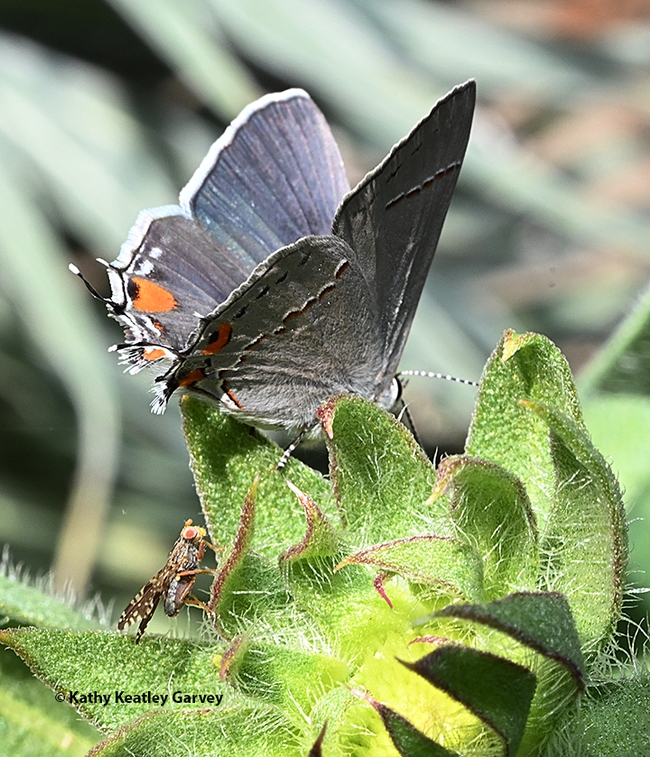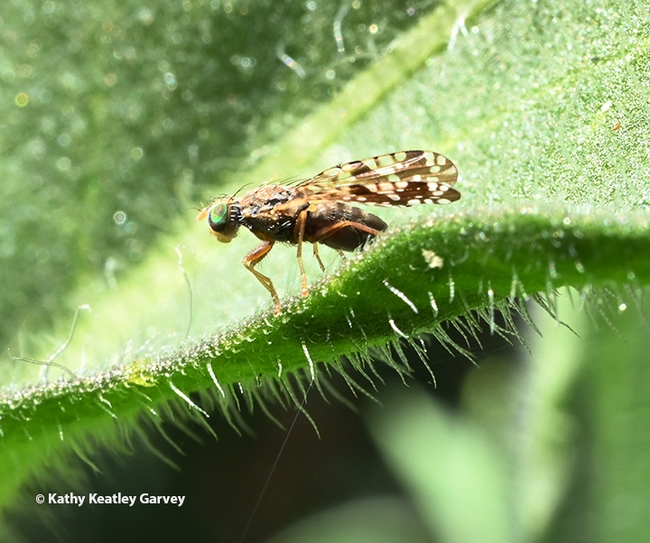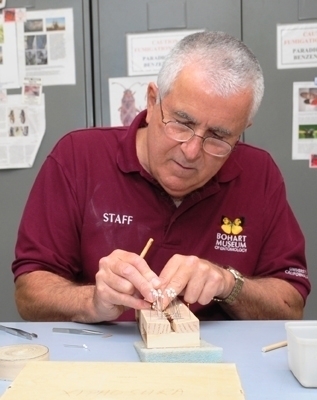- Author: Kathy Keatley Garvey
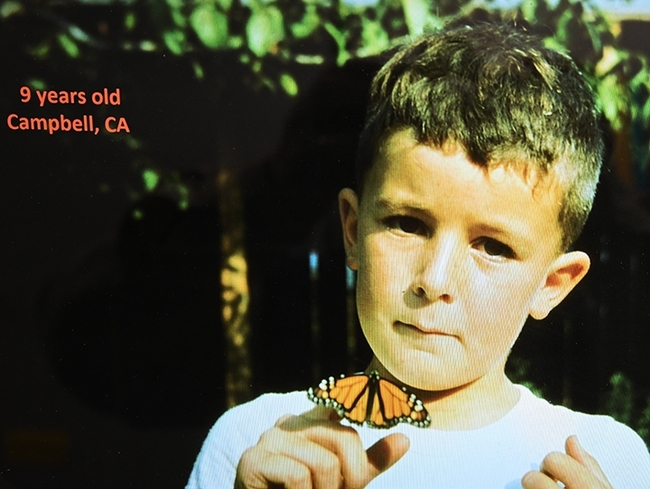
Scientists estimate that only 10 percent of the eggs and 'cats survive to adulthood.
They don't "survive" at all in California classrooms.
California classrooms used to showcase the metamorphosis of the monarch--from egg to caterpillar to chrysalis to adult-- but no more. If you live in California, you're not allowed to collect or rear monarchs without a scientific permit. And scientific permits are difficult to obtain.
According to the California Department of Fish and Wildlife: "A Scientific Collecting Permit (SCP) is required to handle wild monarchs in California including for educational purposes. It is unlawful to collect, remove from the wild and/or captively rear monarchs in California without an SCP, per California Code of Regulations (CCR), Title 14, section 650.
Admire them in the wild, but legally, you can't collect or rear them.
As a child growing up in the San Jose area, entomologist Jeff Smith, curator of the Lepidoptera collection at the Bohart Museum of Entomology, UC Davis, "raised and released many, many dozens of monarchs, as most empty lots were filled with vast stands of narrow-leaf milkweed, and we could easily gather caterpillars and keep them fed and healthy until they matured. This was an extraordinary thing to be able to watch--the final instar of the larva molting to change to the beautiful chrysalis and then seeing the butterfly develop within the chrysalis and hatch. We would hold it on our finger as the wings expanded and, finally, the butterfly flew away."
The Bohart Museum has some seven drawers of monarch specimens. "With around 60 specimens per drawer that could amount to nearly 400 plus specimens (some drawers are not full," he said. The collection also includes nearly-white monarch specimens from Hawaii.
In their book, The Lives of Butterflies: A Natural History of Our Planet's Butterfly Life (Princeton University Press, 2024), authors David James and David Lohman point out that "...our children are the future and it is they who will determine the future of butterflies. If a child finds a caterpillar, let them keep it, feed it, and watch it metamorphose.They will remember the experience for the rest of their life, and it will instill in them a love and appreciation for lives smaller than their own."
James is an entomologist and associate professor at Washington State University who researches migratory monarchs, and Lohman is a biologist, professor and department chair, City College of New York.
“It is important that we do not try to excessively regulate to conserve butterfly populations," they wrote. "We need people to be part of the process and be the power on the ground behind conservation programs.”
They quote Lincoln Brower (1931-2018), a renowned Lepidopterist educated at Princeton and Yale universities: “Butterflies are treasures, like great works of art. Should we not value them as much as the beauty of Picasso's art or the music of Mozart or the Beatles?"
Robert Michael Pyle, founder of the Xerces Society for Invertebrate Conservation, and colleague David L. Wagner, advocated "Keep Nets in the Hands of Kids--and Others" in a piece in the fall edition of the Lepidopterists' Society newsletter. They asked:
"Is the coup de grace for children's face-to-face fascination with small-scale life to be delivered now by well-intentioned but ill-considered regulation?"
Smith declared that the regulation will not "help" with the conservation of monarchs, and that he hopes it will be reversed or modified.
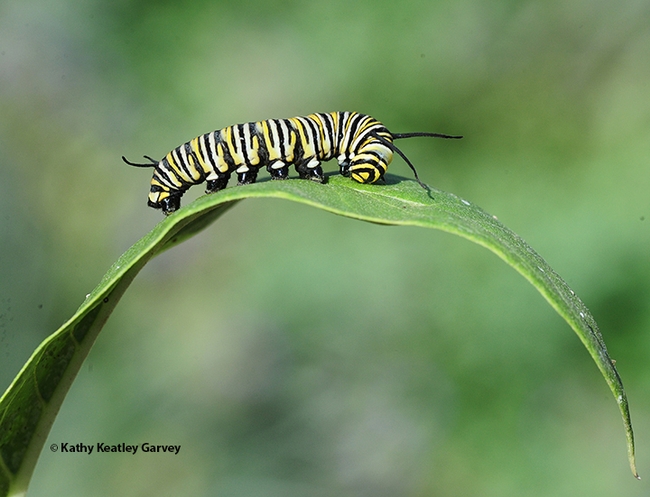
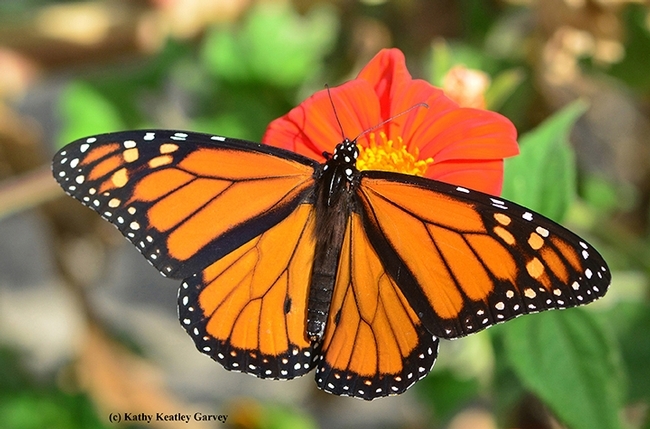
- Author: Kathy Keatley Garvey
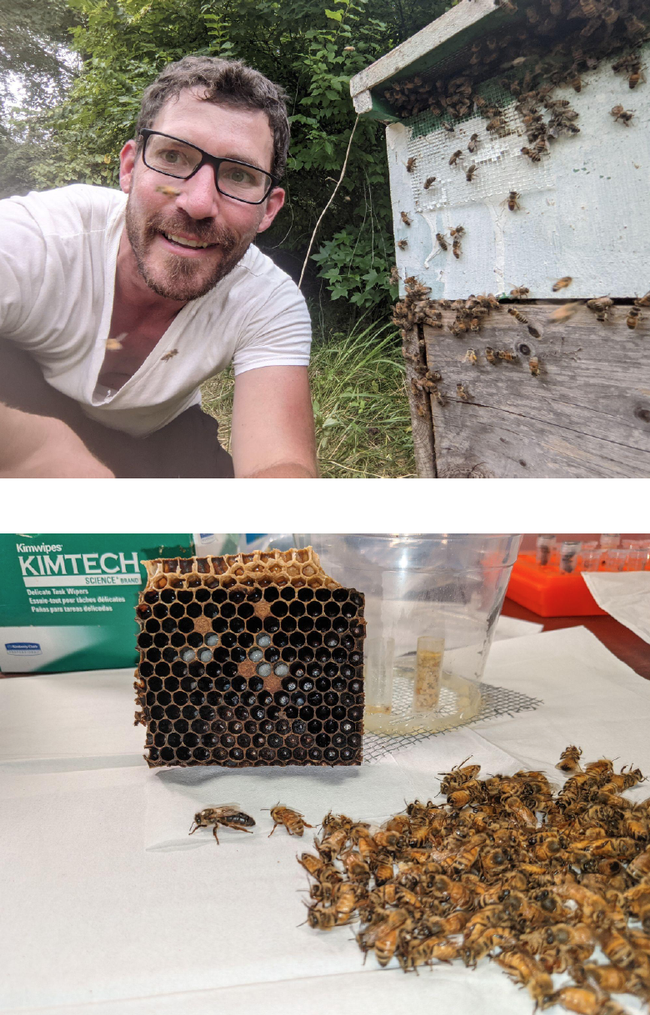
"I took a gap decade. During that time I had a series of eclectic jobs and life experiences. Those experiences proved extremely useful during my PhD."
Lamas, a former commercial beekeeper in New Hampshire, will share his life and research experiences at a seminar hosted by the UC Davis Department of Entomology and Nematology, on Monday, April 15.
His seminar, titled "How Doing a PhD Is Like Building a House," begins at 4:10 p.m. in Room 122 of Briggs Hall. It also will be on Zoom. The Zoom link:
https://ucdavis.zoom.us/j/9 5882849672
"This presentation describes how the intersection of life experiences and my PhD led to creative and generative research that led to large discovery in disease transmission dynamics in collapsing honey bee colonies," Lamas says.
A first-generation college student, Lamas received his bachelor's degree in biology in 2008 from Colby-Sawyer College, a private college in New London, New Hampshire. He obtained his doctorate in entomology at the University of Maryland in 2022.
He credits his mentor, USDA-ARS research entomologist Jay Evans of the Bee Research Laboratory, Beltsville, MD., with encouraging him to apply to become an Oak Ridge Institute for Science and Education (ORISE) fellow with the USDA-ARS Research Participation Program.
Lamas, known as "Dr. Zac," has presented programs on his research and beekeeping management to state beekeeping associations in California, Texas, Florida, Colorado, Virginia, Missouri, West Virginia, and Washington State, among others, and has addressed the American Beekeeping Federation, American Honey Producers' Association and Apimondia. Globally, he has delivered presentations to Apimondia, Montreal, Canada, and to the Eurbee 8th Congress of Apidology, Ghent, Belgium.
Lamas rears open-mated carniolans. "These are docile, productive bees, that I produce for my own experiments," he writes on his website. "We can literally pet our bees during experiments. This level of docility allows us to work intimately with the bees, sitting in front of open colonies for long periods to collect samples."
Lamas is a noted researcher on varroa mites. "Who do Varroa really feed on? Check out this presentation where I share a new finding of Varroa destructor I carried out three years of research, and along with collaborators (including my family!) individually inspected over 30,000 bees to describe the distribution of Varroa inside a colony." (See YouTube presentation.)
Lamas' recent publications involve varroa mites, infectious diseases and pesticides:
- Zachary S. Lamas, Eugene V. Ryabov, David J. Hawthorne, Jay D. Evans, "Oversharing by honey bees and the spread of viruses," bioRxiv 2022.05.15.492017; DOI: https://doi.org/10.1101/2022.05.15.492017
- Ryabov EV, Posada-Florez F, Rogers C, Lamas ZS, Evans JD, Chen Y and Cook SC (2022) "The vectoring competence of the mite Varroa destructor for deformed wing virus of honey bees is dynamic and affects survival of the mite," Frontiers in Insect Science. 2:931352. DOI: 10.3389/finsc.2022.931352
- Posada-Florez, F., Lamas, Z.S., Hawthorne, D.J. et al. "Pupal cannibalism by worker honey bees contributes to the spread of deformed wing virus," Scientific Reports 11, 8989 (2021). https://doi.org/10.1038/s41598-021-88649-y
- Alger, S.A.1, Burnham, P.A., Lamas, Z.S2, Brody, A.K., Richardson, L.R., (2017). "Home sick: impacts of migratory beekeeping on honey bee (Apis mellifera) pests, pathogens, and colony size," PeerJ 6:e5812; DOI 10.7717/peerj.5812
- Kirsten S. Traynor, Dennis vanEngelsdorp, Zachary S. Lamas, "Social disruption: Sublethal pesticides in pollen lead to Apis mellifera queen events and brood loss," Ecotoxicology and Environmental Safety, Volume 214, 2021, 112105, ISSN 0147-6513, https://doi.org/10.1016/j.ecoenv.2021.112105
Honey bee scientist Brian Johnson, associate professor, UC Davis Department of Entomology and Nematology, is coordinating the department's seminars for the 2023-24 academic year. For any Zoom technical issues, he may be reached at brnjohnson@ucdavis.edu.
The complete list of spring quarter seminars is here.
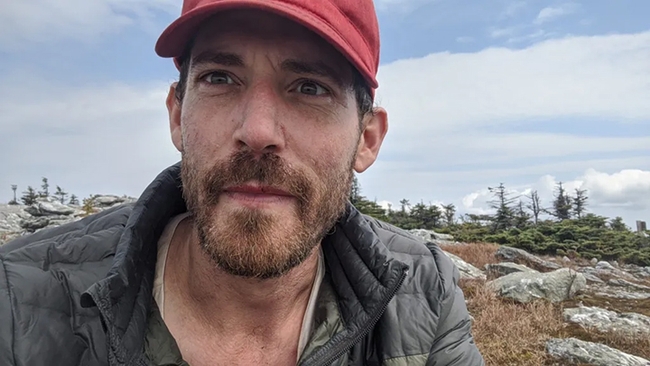
- Author: Kathy Keatley Garvey
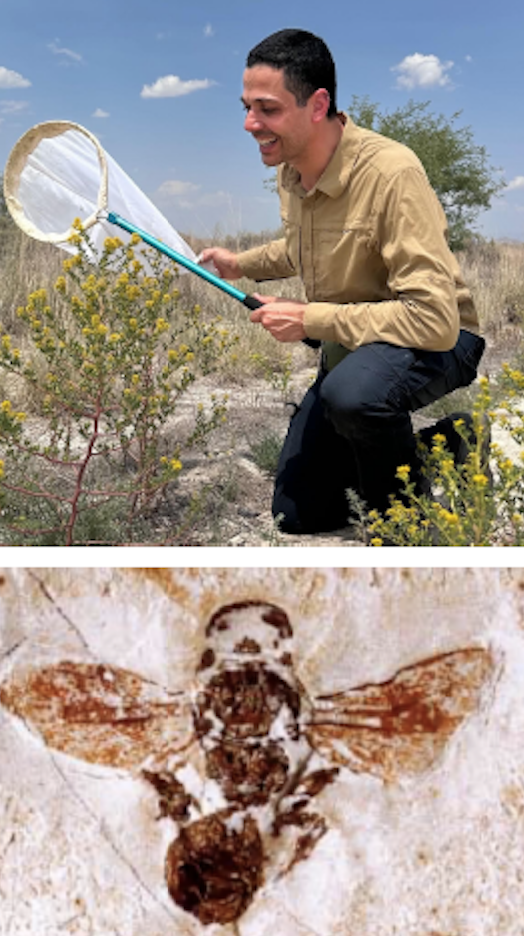
Bees comprise more than 20,000 described species in seven families and are found on all continents except Antarctica, but where did they originate? And when did they originate?
Cornell University alumnus Eduardo Almeida, an associate professor at the University of São Paulo, Brazil, will discuss “The Evolutionary History of Bees in Time and Space” at a seminar hosted by the UC Davis Department of Entomology and Nematology on Monday, April 8.
The seminar begins at 4:10 p.m. in 122 Briggs Hall, and also will be on Zoom. The Zoom link:
https://ucdavis.zoom.us/j/95882849672
"Bees likely originated in the Early Cretaceous (120 million years ago), shortly before the breakup of Western Gondwana (Africa and South America), and the early evolution of any major bee lineage is associated with either the South American or African land masses," Almeida says in his abstract.
"I will present the results of an investigation on bee biogeograpy using extensive new genomic and fossil data to demonstrate that bees originated in Western Gondwana. Bees later colonized northern continents via a complex history of vicariance and dispersal. The notable early absences of these insects from large landmasses, particularly in Australia and India, have important implications for understanding the assembly of local floras and diverse modes of pollination. The partnership between flowering plants and bees began in the Cretaceous, and the history of how bees spread around the world from their hypothesized southern hemisphere origin parallels the histories of numerous plant clades."
Almeida, who joined the University of São Paulo in 2011, conducts research on bee evolution, and is particularly interested in phylogenomics, comparative morphology, biogeography, and associations with host plants.
A native of Brazil, he received his doctorate in 2007 from Cornell University, where he studied with major professor Bryan Danforth. Almedia's focus: the biogeographic history of colletid bees. Prior to enrolling in the doctoral program at Cornell, he obtained his bachelor of science degree (biology) and his master's degree (ecology) from the Universidade Federal de Minas Gerais, Brazil. He speaks Portuguese, English, Spanish and French.
Almeida and his colleagues published a research paper in August 2023 in the journal, Current Biology, on "The Evolutionary History of Bees in Time and Space."
The summary: "Bees are the most significant pollinators of flowering plants. This partnership began ca. 120 million years ago, but the uncertainty of how and when bees spread across the planet has greatly obscured investigations of this key mutualism. We present a novel analysis of bee biogeography using extensive new genomic and fossil data to demonstrate that bees originated in Western Gondwana (Africa and South America). Bees likely originated in the Early Cretaceous, shortly before the breakup of Western Gondwana, and the early evolution of any major bee lineage is associated with either the South American or African land masses. Subsequently, bees colonized northern continents via a complex history of vicariance and dispersal. The notable early absences from large landmasses, particularly in Australia and India, have important implications for understanding the assembly of local floras and diverse modes of pollination. How bees spread around the world from their hypothesized Southern Hemisphere origin parallels the histories of numerous flowering plant clades, providing an essential step to studying the evolution of angiosperm pollination syndromes in space and time."
Coordinating the department's spring seminars is associate professor Brian Johnson. For any technical Zoom issues, he may be reached at brnjohnson@ucdavis.edu.
The complete list of spring quarter seminars is here.
- Author: Kathy Keatley Garvey
The Gulf Fritillary, Agraulis vanillae, is definitely back from a comeback, at least in the Sacramento, Davis and Vacaville-Fairfield areas.
In September of 2009, butterfly guru Art Shapiro, now a UC Davis distinguished professor emeritus, excitedly announced the re-appearance of the Gulf Fritillary butterfly in the Sacramento metropolitan area after a four-decade absence, and in the Davis area after a 30-year absence.
The showy butterfly colonized both south Sacramento and the Winding Way/Auburn Boulevard area in the 1960s but by 1971 "apparently became extinct or nearly so," recalled Shapiro, who has monitored the butterfly populations of central California since 1972 and maintains a research website at https://butterfly.ucdavis.edu.
It's a tropical and subtropical butterfly with a range that extends from the southern United States all the way to central Argentina.
No one knows exactly when the first Gulf Frit first arrived in California, but "it was already in the San Diego area by about 1875, Shapiro says, and it was first recorded in the San Francisco Bay Area around 1908.
A recent piece in The Acorn, published by the Effie Yeaw Nature Center, Carmichael, and authored by UC Davis entomologist Mary Louise Flint (see article), indicated the Gulf Fritillary is doing well in the area.
Good news!
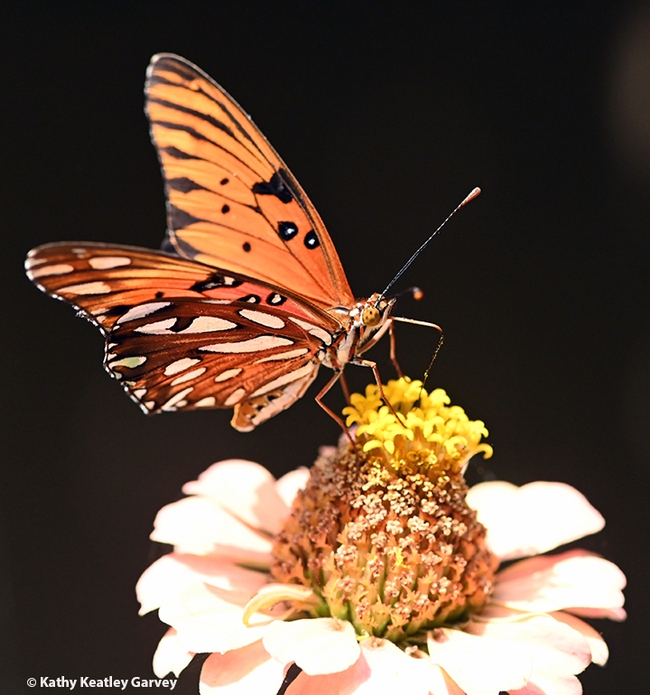
- Author: Kathy Keatley Garvey
A gray butterfly and a fruit fly...
Each has "fly" in its name but one is a member of the order Lepidoptera and the other, order Diptera. Etymology does not agree with entomology.
Ever managed to photograph a butterfly and fruit fly in the same image?
Presenting: a gray hairstreak butterfly, Strymon melinus, and a fruit fly, Neotephritis finalis, an organism commonly known as "the sunflower seed maggot."
They were foraging March 21 in a Vacaville garden on Coreopsis, a genus of flowering plants in Asteraceae.
N. finalis, one of the most commonly seen fruit flies (tephritids) flies in North America. develops in the seed heads of plants in the sunflower family. They're also called "picture-winged flies." BugGuide.net tells us "Wings are mostly dark in apical half with six hyaline spots forming a distinct triangle."
The wings are indeed striking!
But so are the wings of the gray hairstreak butterfly. That orange spot with a black dot on the hindwing probably resembles an eye to a predator.
Butterfly guru Art Shapiro, UC Davis distinguished professor emeritus, says on his research website that the gray hairstreak "is one of the most polyphagous butterflies known, recorded on host plants in many families. Its most frequent hosts in our area are mallows, including the weedy species of Malva; legumes, including Spanish Lotus (Lotus purshianus), Bird's-Foot Trefoil (Lotus corniculatus), White Clover (Trifolium repens) in lawns, Alfalfa (Medicago sativa) and many others; and Turkey Mullein (Eremocarpus or Croton setigerus, Euphorbiaceae)."
Maybe we'll see the butterfly and the fruit fly again...
